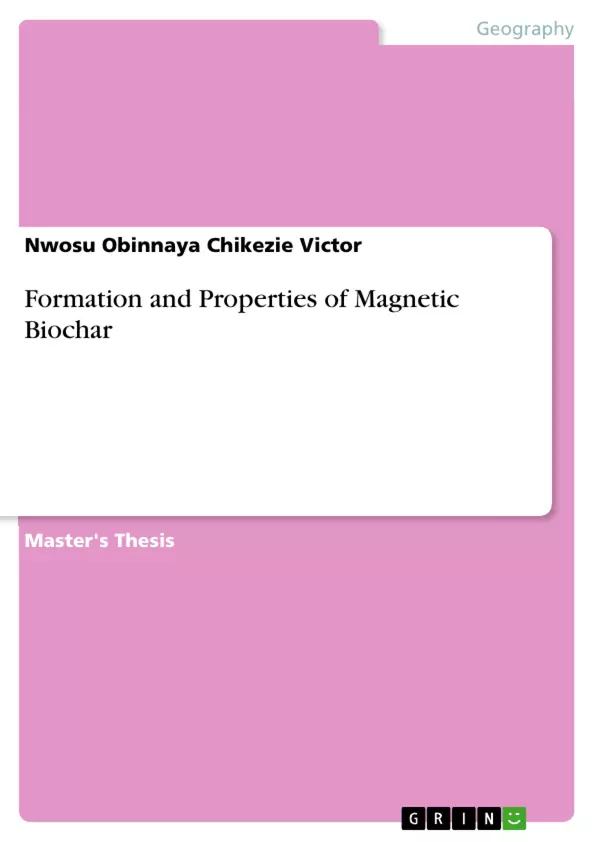
Formation and Properties of Magnetic Biochar
Masterarbeit, 2011
103 Seiten, Note: 3.32/4
Geowissenschaften / Geographie - Phys. Geogr., Geomorphologie, Umweltforschung
Leseprobe
Inhaltsverzeichnis (Table of Contents)
- CHAPTER ONE
- General introduction
- Literature
- Background
- Explanation of Biochar
- Explanation of Biochar Production
- Current and Potential future uses of Biochar
- Explanation of Magnetic Biochar
- Project aim and objectives
- CHAPTER TWO
- Methodology
- Experimental Procedure
- Sample Characterisation
- Adsorption Experiment
- CHAPTER THREE
- Results and discussion
- Characterisation of Samples
- Adsorption analysis of 40ppm of copper (II) sulphate pentahydrate With 1.0 M iron solution magnetic biochar
- Adsorption analysis of 60ppm of Copper (II) sulphate pentahydrate with 1.0 M, 0.1 M Iron solution magnetic biochar and Activated charcoal nitrot
- Adsorption analysis of 3.0ppm of Copper (II) sulphate pentahydrate with 1.0 M, 0.1 M Iron solution magnetic biochar and Activated nitrot
- CHAPTER FOUR
- Conclusion and Suggestions for Further Work
- Conclusion
- Suggestions for Further Work
- REFERENCES
Zielsetzung und Themenschwerpunkte (Objectives and Key Themes)
This thesis aims to explore the formation and properties of magnetic biochar, specifically its application as a potential adsorbent for the removal of heavy metals from aqueous solutions. The study focuses on the development of a novel magnetic biochar material and its characterization through various experimental techniques.
- Formation and characterization of magnetic biochar.
- Evaluation of magnetic biochar's effectiveness as an adsorbent for heavy metals.
- Comparison of magnetic biochar's performance to traditional adsorbents like activated charcoal.
- Exploration of the influence of iron concentration on the adsorption process.
- Potential environmental applications and future directions for magnetic biochar research.
Zusammenfassung der Kapitel (Chapter Summaries)
Chapter One provides a comprehensive introduction to biochar, its production methods, current and potential future uses, and a detailed explanation of magnetic biochar. This chapter also outlines the project's specific aims and objectives.
Chapter Two delves into the methodology employed in the research. It details the experimental procedures, including sample preparation, characterization techniques, and the adsorption experiments conducted. The chapter also outlines the specific procedures used for characterizing samples and conducting adsorption analyses.
Chapter Three presents the results obtained from the research, focusing on the characterization of the magnetic biochar samples and the adsorption analysis of copper (II) sulphate pentahydrate. The chapter analyzes the data obtained from various adsorption experiments, exploring the influence of different iron concentrations on the adsorption process.
Schlüsselwörter (Keywords)
The main keywords and focus topics of this thesis include biochar, magnetic biochar, adsorption, heavy metals, copper (II) sulphate pentahydrate, environmental remediation, and sustainable technologies.
Details
- Titel
- Formation and Properties of Magnetic Biochar
- Hochschule
- University of Teesside
- Veranstaltung
- Environmental Technology
- Note
- 3.32/4
- Autor
- Nwosu Obinnaya Chikezie Victor (Autor:in)
- Erscheinungsjahr
- 2011
- Seiten
- 103
- Katalognummer
- V1253724
- ISBN (Buch)
- 9783346699923
- Sprache
- Englisch
- Schlagworte
- formation properties magnetic biochar
- Produktsicherheit
- GRIN Publishing GmbH
- Preis (Ebook)
- US$ 39,99
- Preis (Book)
- US$ 50,99
- Arbeit zitieren
- Nwosu Obinnaya Chikezie Victor (Autor:in), 2011, Formation and Properties of Magnetic Biochar, München, Page::Imprint:: GRINVerlagOHG, https://www.diplomarbeiten24.de/document/1253724
- Autor werden
- Ihre Optionen
- Vertriebskanäle
- Premium Services
- Autorenprofil
- Textarten und Formate
- Services für Verlage, Hochschulen, Unternehmen

- © GRIN Publishing GmbH.
- Alle Inhalte urheberrechtlich geschützt. Kopieren und verbreiten untersagt.
- info@grin.com
- AGB
- Open Publishing
Der GRIN Verlag hat sich seit 1998 auf die Veröffentlichung akademischer eBooks und Bücher spezialisiert. Der GRIN Verlag steht damit als erstes Unternehmen für User Generated Quality Content. Die Verlagsseiten GRIN.com, Hausarbeiten.de und Diplomarbeiten24 bieten für Hochschullehrer, Absolventen und Studenten die ideale Plattform, wissenschaftliche Texte wie Hausarbeiten, Referate, Bachelorarbeiten, Masterarbeiten, Diplomarbeiten, Dissertationen und wissenschaftliche Aufsätze einem breiten Publikum zu präsentieren.
Kostenfreie Veröffentlichung: Hausarbeit, Bachelorarbeit, Diplomarbeit, Dissertation, Masterarbeit, Interpretation oder Referat jetzt veröffentlichen!
- GRIN Verlag GmbH
-
- Nymphenburger Str. 86
- 80636
- Munich, Deutschland
- +49 89-550559-0
- +49 89-550559-10
- info@grin.com
-









